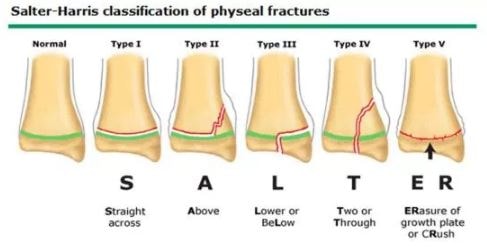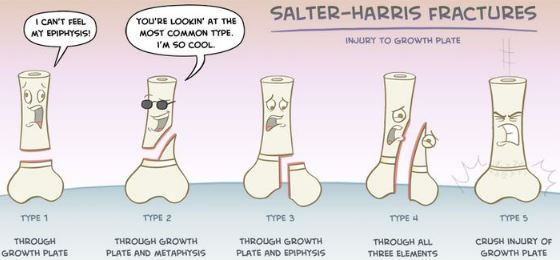Salter Harris Fracture
What is Salter Harris Fracture?
Salter Harris Fracture is one of the common fractures that are seen. When the fracture occurs at the epiphyseal plate or the growth plate of the bone, then it is called as the Salter Harris Fracture. This is one of the most important and critical fractures seen among people.

This can lead to serious complications and disturbances. The Salter Harris Fracture can be very dangerous as it can result in premature closure of the growth plate and thus resulting abnormal growth of the bone.
However, it has been observed that the children are the common sufferers of the fracture. If Epidemiology is concerned then almost 35% of the skeleton injuries to the children can be blamed upon the Salter Harris Fracture.
Classification of Salter Harris Fracture
The Salter Harris Fracture has been classified into nine types as per the occurrence, positions and other factors. The Type I to Type V classification was made by Robert B Salter and W Robert Harris. The next four classifications have been added subsequently.

The classification of the Salter Harris Fracture is the most important part as this defines the criticalness and the severity of the issue. Basically, the growth plate has five different zones and each one has different strength. The fracture generally occurs at the weakest zones. The Epiphysis zone of the growth plate can cause the closure of the plate.
Type – I
This is one of the rarest Type of Salter Harris Fracture. In this type, the fracture passes through the growth plate and spares the bone. It is generally slipped fracture and has good prognosis rate. The occurrence rate of Type I is around 5%-7%.

Image 3 – Percentage of salter harris fracture occurence among types
Type –II
This is probably the most common Salter Harris Fracture. The fracture, in this case, passes the growth plate by large and affects the metaphysis. The rate of occurrence of the Salter Harris Fracture is almost 75%. This has a very good prognosis rate. It takes about 2-3 weeks to get healed.
Type- III
This happens at the lower part of the growth plate. The fracture in this case basically passes along the growth plate and disrupts the Epiphysis. The chance of occurrence for this type of Salter Harris Fracture is mere 7%-10%.
However, very poor prognosis leads the complication in this case. This could be termed as the one of the most critical Salter Harris Fracture Types in the list of classifications.
Type – IV
This is even worse than the previous one. The growth plate fracture occurs through the inter-articular region. In other words, it can be said that the fracture occurs at the growth plate, metaphysis and epiphysis together.
The occurrence chance of the Type IV fracture is almost 9%-11%. However, same like the Type III, poor prognosis leads complication and severity. This is also considered one of the most critical Salter Harris Fracture Types.
Type – V
This is the very rare type of fracture to the growth plate. It is a kind of crushing of the growth plate. However, it does not really displace the plate but damages it badly. It can be said that the space between the metaphysis and epiphysis gets reduced and can be observed in the X-Rays.
The occurrence chances are lesser than 1% for this Type. However, if occurs, then it can be very difficult to deal with. This has the worst prognosis and can be hard to handle.
As said earlier, there were subsequent additions to the existing classifications of the Salter Harris Fracture. The new additions are very rare and seldom seen. But the possibilities of these types cannot be denied.
Type – VI
This was added in the year of 1969 by Mercer Rang. This happens when the injury directly impacts the peripheral portion of the physis. Due to the direct injury, bridge formation can be observed in the growth plate. Well, this ultimately results in the angular deformity. However, the possibilities of angular deformities are not so confirmed in every Type V classifications.
Type – VII
This was added by JA Ogden. The definition of the classification is given as the isolated injury to the epiphyseal plate. This directly impacts the epiphysis area of the growth plate.
Type- VIII
This is also an isolation injury, but the impact area is metaphysis area. However, this classification also proposes the considerable and potential threat of injury to the endochondral ossification.
Type – IX
This is an injury to the Periosteum area of the growth plate. However, it also has the potential injury to the intramembranous ossification.
Treatment of Salter Harris Fracture
The treatment of the Salter Harris Fracture depends upon numerous factors such as severity, locations, classifications, age and others.
Closed Reduction
This is one of the most commonly used methods of treatments for the Salter Harris Fracture. The casting and splinting are also used in this type of reduction. However, this needs complete relaxation and rest.
The outcome of the treatment mostly depends upon the muscular activities during the treatment and the age of the patient. It has been observed that the patients with young age gets more benefit of this treatment and the complication gets increased with the age.
The Type I and Type II Salter Harris Fracture can be handled with this kind of treatment. The time of the treatment may vary according to the condition of the patient. Mostly, the time varies from 1 week to 4 weeks.
Surgical Therapy
This is again one of the crucial treatments for the Salter Harris Fracture in the severe cases. Type III onwards Salter Harris Fractures are generally treated with the Surgical Therapies where the Anatomic Reduction is used. The Open Reduction and internal Fixation are two important aspects of the treatment. Smooth pins are generally used to better the fracture without touching the physis. Oblique applications and internal fixation devices are also used as per the situations.
The entire treatment, however, depends upon the patient and the classification of the Salter Harris Fracture. With the advancement of the medical sciences, more treatments may soon come to address the Salter Harris Fracture.
References
- http://radiopaedia.org/articles/salter-harris-fractures
- https://en.wikipedia.org/wiki/Salter%E2%80%93Harris_fracture
- http://radiopaedia.org/articles/salter-harris-fracture-classification-mnemonic
- http://emedicine.medscape.com/article/412956-overview
- http://emedicine.medscape.com/article/1260663-treatment
- https://www.med-ed.virginia.edu/courses/rad/peds/ms_webpages/ms2bsalter.html
- http://orthoinfo.aaos.org/topic.cfm?topic=A00040
